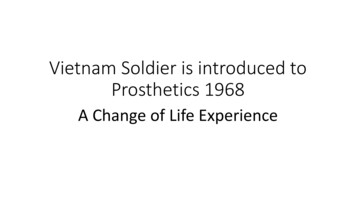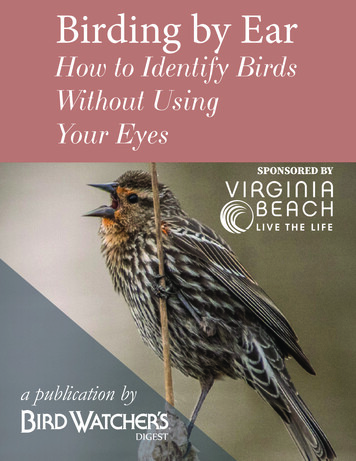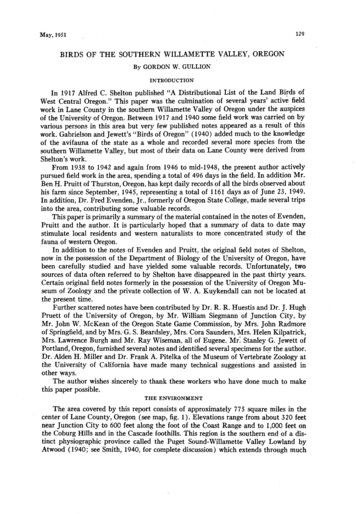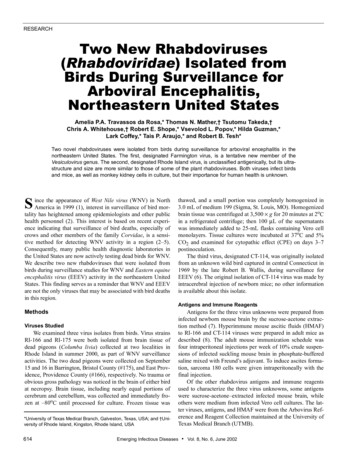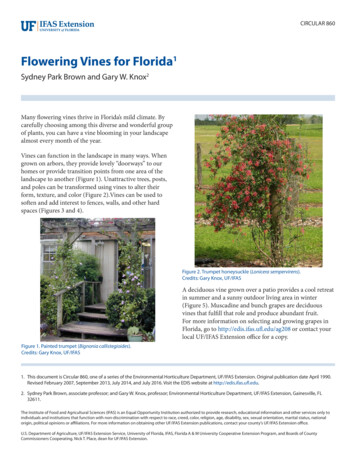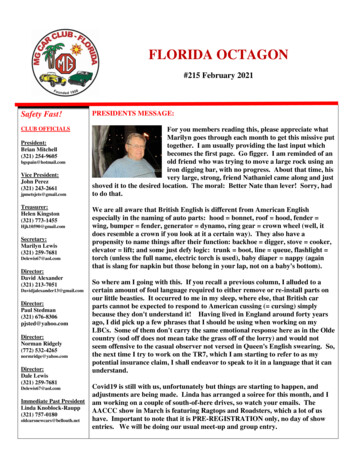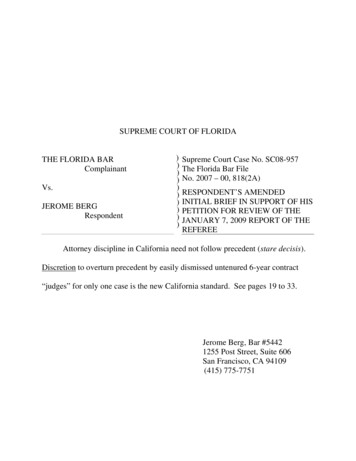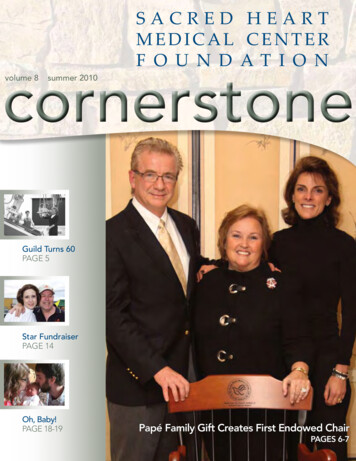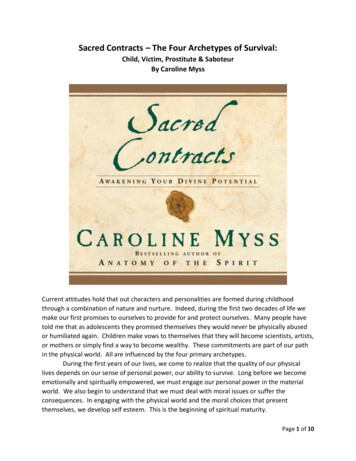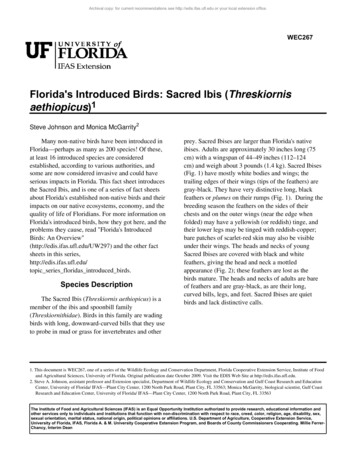
Transcription
Archival copy: for current recommendations see http://edis.ifas.ufl.edu or your local extension office.WEC267Florida's Introduced Birds: Sacred Ibis (Threskiornisaethiopicus)1Steve Johnson and Monica McGarrity2Many non-native birds have been introduced inFlorida—perhaps as many as 200 species! Of these,at least 16 introduced species are consideredestablished, according to various authorities, andsome are now considered invasive and could haveserious impacts in Florida. This fact sheet introducesthe Sacred Ibis, and is one of a series of fact sheetsabout Florida's established non-native birds and theirimpacts on our native ecosystems, economy, and thequality of life of Floridians. For more information onFlorida's introduced birds, how they got here, and theproblems they cause, read "Florida's IntroducedBirds: An Overview"(http://edis.ifas.ufl.edu/UW297) and the other factsheets in this series,http://edis.ifas.ufl.edu/topic series floridas introduced birds.Species DescriptionThe Sacred Ibis (Threskiornis aethiopicus) is amember of the ibis and spoonbill family(Threskiornithidae). Birds in this family are wadingbirds with long, downward-curved bills that they useto probe in mud or grass for invertebrates and otherprey. Sacred Ibises are larger than Florida's nativeibises. Adults are approximately 30 inches long (75cm) with a wingspan of 44–49 inches (112–124cm) and weigh about 3 pounds (1.4 kg). Sacred Ibises(Fig. 1) have mostly white bodies and wings; thetrailing edges of their wings (tips of the feathers) aregray-black. They have very distinctive long, blackfeathers or plumes on their rumps (Fig. 1). During thebreeding season the feathers on the sides of theirchests and on the outer wings (near the edge whenfolded) may have a yellowish (or reddish) tinge, andtheir lower legs may be tinged with reddish-copper;bare patches of scarlet-red skin may also be visibleunder their wings. The heads and necks of youngSacred Ibises are covered with black and whitefeathers, giving the head and neck a mottledappearance (Fig. 2); these feathers are lost as thebirds mature. The heads and necks of adults are bareof feathers and are gray-black, as are their long,curved bills, legs, and feet. Sacred Ibises are quietbirds and lack distinctive calls.1. This document is WEC267, one of a series of the Wildlife Ecology and Conservation Department, Florida Cooperative Extension Service, Institute of Foodand Agricultural Sciences, University of Florida. Original publication date October 2009. Visit the EDIS Web Site at http://edis.ifas.ufl.edu.2. Steve A. Johnson, assistant professor and Extension specialist, Department of Wildlife Ecology and Conservation and Gulf Coast Research and EducationCenter, University of Florida/ IFAS—Plant City Center, 1200 North Park Road, Plant City, FL 33563; Monica McGarrity, biological scientist, Gulf CoastResearch and Education Center, University of Florida/ IFAS—Plant City Center, 1200 North Park Road, Plant City, FL 33563The Institute of Food and Agricultural Sciences (IFAS) is an Equal Opportunity Institution authorized to provide research, educational information andother services only to individuals and institutions that function with non-discrimination with respect to race, creed, color, religion, age, disability, sex,sexual orientation, marital status, national origin, political opinions or affiliations. U.S. Department of Agriculture, Cooperative Extension Service,University of Florida, IFAS, Florida A. & M. University Cooperative Extension Program, and Boards of County Commissioners Cooperating. Millie FerrerChancy, Interim Dean
Archival copy: for current recommendations see http://edis.ifas.ufl.edu or your local extension office.Florida's Introduced Birds: Sacred Ibis (Threskiornis aethiopicus)Figure 1. The Sacred Ibis (Threskiornis aethiopicus) issimilar in appearance to native ibises, but is much larger.This invasive bird also looks very similar to the nativeWood Stork. However, the bill of the Sacred Ibis is moreslender and curved; the head, neck, bill, legs, and feet aremuch darker black; and it has long black plumes on itsrump. Credit: Richard Mittleman (www.gon2foto.com),2006 Credits:Figure 2. Juvenile Sacred Ibises are similar in appearanceto adults, but their heads and necks are covered with blackand white feathers. This gives the head and neck a mottledappearance, making it easy to confuse young birds withendangered native Wood Storks. However, even youngSacred Ibises have the characteristic black plumes on theirrumps. Credit: Helen Harris, Kenya Birds(www.kenyabirds.org.uk), 2009 Credits:Figure 3. The White Ibis (Eudocimus albus) is smaller thanthe invasive Sacred Ibis, and is nearly solid white with areddish bill, legs, and feet. The head and neck are coveredwith white feathers. Only the tips of the wings are black,and the black wing tips are usually hidden unless the bird isin flight. Credit: Steve A. Johnson, University of Florida,2005 Credits:Figure 4. The endangered Wood Stork (Mycteriaamericana) is larger than the Sacred Ibis, and the head,neck and bill are much lighter and marked with gray andtan. Notice that the black outer feathers of the wings canbe seen even when the wings are folded. Credit: Steve A.Johnson, University of Florida, 2005 Credits:2
Archival copy: for current recommendations see http://edis.ifas.ufl.edu or your local extension office.Florida's Introduced Birds: Sacred Ibis (Threskiornis aethiopicus)3Similar SpeciesSacred Ibises are somewhat similar inappearance to the native White Ibis (Eudocimusalbus), but are larger. Adult White Ibises (Fig. 3) areapproximately 22–27 inches (56–68 cm) long,weigh about 1.5–2.5 pounds (750–1,050 g), andhave a wingspan of only 38 inches (96.5 cm). Thefeathers of White Ibises are mostly white—only thethree feathers at the tips of their wings are tipped withblack. They also have feathered white heads and theirbills, legs, and feet are an obvious reddish-pink, notblack like those of Sacred Ibises. During the breedingseason, White Ibises' reddish bills are tipped withblack.Sacred Ibises look very similar to the nativeWood Stork (Mycteria americana), a member of thestork family (Ciconiidae) that is federally listed as anendangered species. Wood Storks (Fig. 4) are largerthan Sacred Ibises, and have a more erect bodyposture when resting than ibises (Fig. 5). WoodStorks also have lighter-colored heads and necks withgrayish or tan markings (Fig. 4). Young Sacred Ibises(Fig. 2) look especially similar to Wood Storks, dueto the mottled appearance of the black and whitefeathers on their heads and necks. However, the billsof Wood Storks are mostly straight and only thelower third of the bill curves downward (Fig. 5A);ibis bills form a long, continuous curve (Fig. 5B &C). Wood Stork bills are mostly brown, and only thebase of the bill is black; Sacred Ibises have solidblack bills. Wood Storks also lack the characteristicblack plumes seen on the rumps of Sacred Ibises.Resting Wood Storks can also be identified by theirblack outer (primary) feathers (the edges of theirwings are black), which are visible even when theirwings are folded (Fig. 4).All three of these species look very similar whenviewed from the underside as they fly overhead.Sacred Ibises have white wings with a black trailingedge (Fig. 6A); during the breeding season they mayalso have bare patches of scarlet skin under theleading edge of the wing. Adult White Ibises havenearly solid white wings with black tips (Fig6B).Wood Storks have much more black on theirwings—all of the outermost feathers are black (Fig6C).Figure 5. Native Wood Storks (A) have a much more erectstance when seen in silhouette, and only the tip of the billis curved. Sacred Ibises (B) and native White Ibises (C)both have bills that are curved along the entire length andhave similar silhouettes, but invasive Sacred Ibises aremuch larger than the native ibis. Credit: Florida Fish andWildlife Conservation Commission, 2009 Credits:Figure 6. The patterns on the undersides of their wingscan be used to identify invasive Sacred Ibises in flight.Sacred Ibises (A) have white wings with a black trailingedge, and may have patches of bare, scarlet-red skinunder the leading edges of the wings during the breedingseason (stippled black when viewing in black-and-white).White Ibises (B) have nearly solid white wings with blacktips. Endangered Wood Storks (C) have white wings withblack outer feathers. Credit: Monica McGarrity, Universityof Florida, 2009 (Modified from basic bird wing outline byMuriel Gottrop, Wikimedia Project, 2008) Credits:Native Range and HabitatsSacred Ibises are native to sub-Saharan Africa,the Middle East, and Madagascar; historically, theywere also found in Egypt, where they are now extinct.
Archival copy: for current recommendations see http://edis.ifas.ufl.edu or your local extension office.Florida's Introduced Birds: Sacred Ibis (Threskiornis aethiopicus)These large birds are often depicted in Egyptianhieroglyphs as the earthly representation of the godThoth (also shown as an ibis-headed man) and wereconsidered sacred—hence the common name. Theyare very similar in appearance and so closely relatedto the Black-headed Ibis (T. melanocephalus) inSouth Asia and the Australian White Ibis (T.molucca) that many scientists consider the three a"superspecies," and some believe they may actuallyall be the same species. In their native range, theyinhabit coastal estuaries, lagoons, marshes, and otherinland wetlands such as flooded agricultural fieldsand urban retention ponds.4found in close proximity to urban areas, especiallywaste management dumps, golf courses, and urbanlakes. Although introduced Sacred Ibises have onlybeen found in southern Florida, scientists believe thatthe flexible habitat requirements of this species couldallow them to expand their range to include otherareas of Florida. Identifying and reporting thepresence of these invasive birds is extremelyimportant, so that scientists can capture and removethem and thus prevent these birds from becomingestablished and spreading. For more information onefforts to control Sacred Ibises in Florida, see the"Solutions" section below.Mode of IntroductionThe widespread destruction caused by HurricaneAndrew in 1992 resulted in the accidental release ofmany species of non-native wildlife in Florida,including Sacred Ibises. It is believed that the SacredIbises found living in the wild in Florida havedescended from animals that escaped during thisnatural disaster. Five individuals escaped from theMiami Metro Zoo during or after the hurricane, butremained near the zoo. Although these animals wereseen breeding nearby in the following years, the zoowas able to capture and remove young birds from thenests before they could disperse. However, thenumber of Sacred Ibises seen near the zoo graduallyincreased, suggesting that Hurricane Andrew mayalso have resulted in the escape of additional birdsfrom private bird collections in the Miami area.Introduced Range and HabitatsIn the United States, introduced Sacred Ibiseshave only been found in areas of southern Florida(Fig. 7), including Everglades National Park and theArthur R. Marshall Loxahatchee National WildlifeRefuge. Escapes from zoos have also resulted in theintroduction of Sacred Ibises in many parts ofEurope. There are now established breeding coloniesin Spain, France, Italy, Belgium, the Netherlands, andGermany.Introduced Sacred Ibises can inhabit a widevariety of wetland and upland habitats, includingcoastal estuaries, lagoons, and marshes; inlandwetlands and marshes; agricultural fields (flooded ornot); and urban retention ponds. They are usuallyFigure 7. Approximate United States range of theintroduced Sacred Ibis (Threskiornis aethiopicus). Credit:Monica McGarrity, University of Florida, 2009 (Datasource: Everglades Cooperative Invasive SpeciesManagement Area) Credits:EcologyThe diet of Sacred Ibises is broad and includes awide variety of prey items. The generalist diet of thisspecies may help it to successfully invade and survivein new areas. Sacred Ibises often forage in groups of2–20 individuals, using their long, curved bills toprobe mud or grass for prey or scavenge for scraps ingarbage. They will eat virtually anything thatmoves—insects, worms, crayfish, mollusks, otherinvertebrates, small fish, amphibians, and smallrodents. Sacred Ibises can also prey on the eggs andnestlings of other birds, especially seabirds. Inaddition, in urban areas they are often found neartrash heaps, where they eat a variety of scraps andother refuse.
Archival copy: for current recommendations see http://edis.ifas.ufl.edu or your local extension office.Florida's Introduced Birds: Sacred Ibis (Threskiornis aethiopicus)Like many wading birds, Sacred Ibises roost intrees at night, often in large groups of hundreds ofbirds, sometimes with birds of other species. SacredIbises are usually the last birds to arrive at roosts eachevening, often showing up well after sunset. Theybreed near their foraging and roosting grounds, andmay nest individually or build large, communalplatforms of sticks that hold as many as 30 nests.Each pair builds a nest of twigs, in which the femalelays 2–3 eggs. The eggs hatch in 28–29 days, andthe young remain in the colony for an additional44–48 days; both the male and female care for theeggs and young birds. In the Everglades, SacredIbises roost and nest on tree islands, often amongnative species.Ecological ImpactsSacred Ibises are one of only a few species in thebird Order Ciconiiformes (herons, storks, ibises,spoonbills) that prey on the eggs and nestlings ofother birds. In their native range in Africa, SacredIbises eat the eggs of seabirds, including gulls, terns,cormorants, pelicans, and gannets. In their nativerange, Sacred Ibises take enough eggs and youngfrom one Cape Cormorant (Phalacrocorax capensis)colony each year that they are considered one of theleading causes of mortality of these imperiled birds.Scientists studying seabird colonies in Europe havealso found that predation by introduced Sacred Ibisesis a significant problem.We know very little about the impacts of SacredIbises in Florida. In Europe, Sacred Ibis populationshave been known to grow exponentially, increasingtheir numbers from hundreds to thousands within fiveto ten years. Without aggressive, concentratederadication efforts by wildlife professionals (see"Solutions" below), these large birds could proliferateand might eventually have negative impacts on ournative species. Most importantly, Sacred Ibises inFlorida nest in the same areas (and even in the samecolonies) as endangered Wood Storks, and couldprey on their eggs and young. Although Sacred Ibisesin Florida have not been reported nesting withseabirds or preying on their eggs or young, Florida isalso home to several threatened seabird species. IfSacred Ibises were allowed to become establishedand proliferate, they could cause harm to thesespecies as well.5Impacts on People and PetsThe impacts of invasive Sacred Ibises on humanswould likely be minimal. Like all birds, ibises cancarry a variety of disease-causing agents (bacteria,viruses, etc.) that can spread to humans, so their fecescould pose a health risk. Sacred Ibises often forage inhuman garbage for scraps, and could become anuisance if populations were allowed to becomeestablished.SolutionsLocal governments (e.g., Palm Beach County),Florida Fish and Wildlife Conservation Commission(FWC), and the United States Department ofAgriculture Wildlife Services Office(USDA/APHIS/WS) have teamed up to attempt toeradicate invasive Sacred Ibises. At this time, expertsbelieve that all Sacred Ibises living in the wild insouth Florida have been removed—approximately 75birds total. Scientists are cautiously hopeful that theSacred Ibis has proven to be a "success story" forinvasive species management, and that these invasivebirds may have already been eradicated. Efforts tomanage Sacred Ibises and other invasive birds havegained increasing support from conservationsocieties, including the Florida Audubon Society,because of the serious threat that they pose to nativespecies. Florida's citizens can also play an importantrole in efforts to manage invasive birds. For moreinformation on what you can do, see "How you canhelp" below.How You Can HelpYou can help to manage invasive species bybecoming part of Florida's invasive species detectionand rapid response network. Use the tips in this factsheet to learn to identify Sacred Ibises, and keep youreyes open—especially in southern Florida! If youthink you have spotted a Sacred Ibis, try to take aphoto so that wildlife biologists can use it to confirmyour sighting, and report it immediately. Never try tocapture or kill a bird you think is a Sacred Ibis, sinceyou could accidentally harm an endangered, nativeWood Stork. Eradication is best left to professionalwildlife removal experts.
Archival copy: for current recommendations see http://edis.ifas.ufl.edu or your local extension office.Florida's Introduced Birds: Sacred Ibis (Threskiornis aethiopicus)Sacred Ibises have been found at several sitesacross south Florida (shown in Fig. 8), and all knownindividuals have been removed, so it is especiallyimportant to report sightings in new locations. Youshould immediately report the number of birds andtheir exact location to the FWC by contacting LarryConnor (e-mail: ExoticReports@myfwc.com; Phone:(352) 357-2398). If possible, please e-mail digitalphotos of the birds along with your report, or contactLarry Connor for a mailing address for non-digitalphotos. After the FWC verifies the sighting, it will bereported to the USDA/APHIS/WS and shared withother agencies and groups working to deal with thegrowing problem of invasive wildlife in Florida.In the coming years, Florida's scientists andgovernment agencies plan to organize and trainconcerned citizens like you to create an officialnetwork of volunteers that will help to rapidly detect,report, and respond to new wildlife invasions. Thesupport of citizens who are concerned with protectingFlorida's native wildlife and ecosystems will becritical to the development and success of thisnetwork.You can also help to alleviate the growingnumbers of non-native bird species in Florida bybeing a responsible and educated pet owner. Neverset any pet free outside! Finally, you can also help bylearning more about invasive plants and animals andtheir impacts on Florida's natural environment, andby educating others. For more information onFlorida's introduced birds and how you can help, read"Florida's Introduced Birds: An Overview"(http://edis.ifas.ufl.edu/uw297), and check out theAdditional Resources listed below.Additional ResourcesThere are a variety of online guides, books andother publications that we recommend for additionalinformation on Florida's native and non-nativebirds.Books and Scientific PublicationsAlsop, Fred J., Smithsonian Handbooks: Birds ofNorth America – Eastern Region. (New York: DKPublishing, Inc., 2001).Figure 8. Documented locations of introduced Sacred Ibis(Threskiornis aethiopicus) sightings in Florida. Multiplesightings in nearby areas are shown by a single larger dotfor ease of viewing. Check for new sightings of SacredIbises (and other introduced species) in your area byviewing the distribution maps on the EvergladesCooperative Invasive Species Management Area websiteat http://www.evergladescisma.org/distribution. Credit:Monica McGarrity, University of Florida, 2009 (Datasource: Everglades Cooperative Invasive SpeciesManagement Area) Credits:Bull, J., and J. Farrand, Jr., The Audubon SocietyField Guide to North American Birds. (New York:Alfred A. Knopf, 1977).Clergeau, P., and P. Yésou, "Behavioural flexibilityand numerous potential sources of introduction forthe sacred ibis: causes of concern in westernEurope?" Biological Invasions 8 (2006): 1381-1388.Herring, G., and D. E. Gawlik, "Potential forsuccessful population establi
Florida's Introduced Birds: Sacred Ibis (Threskiornis aethiopicus)1 Steve Johnson and Monica McGarrity2 1. This document is WEC267, one of a series of the Wildlife Ecology and Conservation Department, Florida Cooperative Extension Service, Institute of Food . edge, and may have patches of bare, sca
